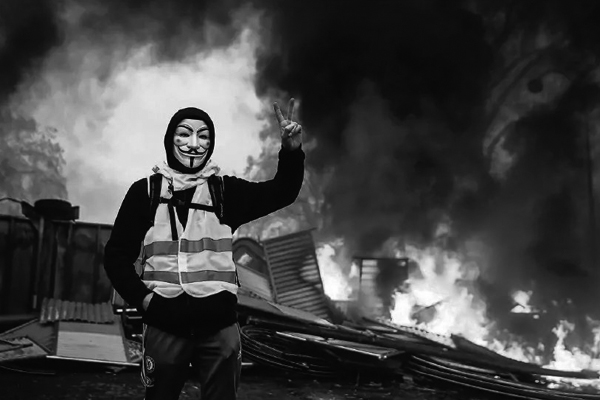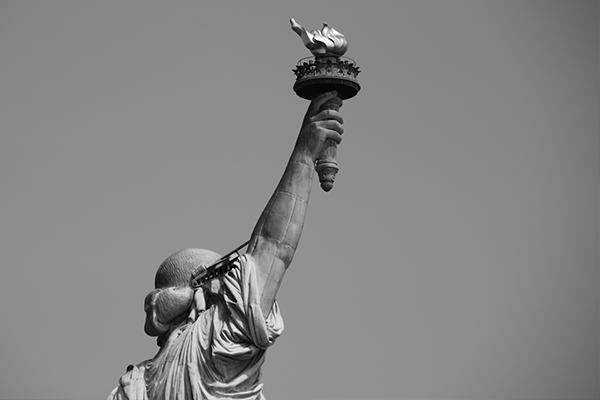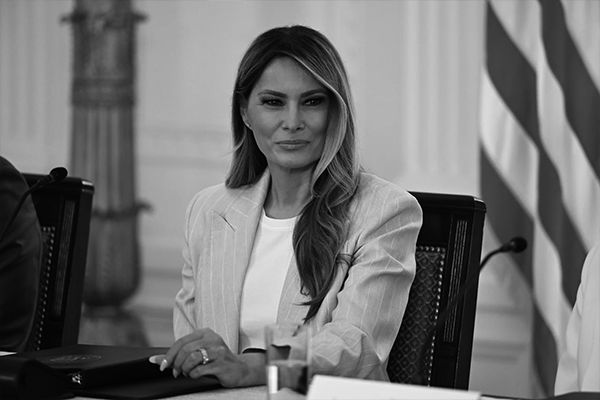
French politics is living through a peculiar chapter. The fate of Prime Minister François Bayrou seems sealed. Yet the true stage of the dispute is not the National Assembly but the digital realm. Algorithms and bots amplify messages like war drums. Seemingly trivial memes —such as that of ‘Citizen Nicolas,’ a virtual office worker overwhelmed by taxes— have turned into symbolic structures capable of mobilizing thousands. Reinforced by AI, they repeat, recombine, and project emotions on a massive scale. These digital armies do more than spread ideas: they shape perceptions, magnify popular indignation, and implant the sense that a noisy minority speaks for the majority.
Meanwhile, movements like ‘Block Everything’ transfer online outrage into the streets. They are coordinated through platforms that function like hives. Artificial intelligence organizes the conversation, inflates it, directs it, and turns it into political spectacle. Analysts warn that it is no longer the parties that write the script. It is the machines now able to turn slogans into trends and trends into votes. Once Bayrou falls, who will govern France —new politicians, citizens, or algorithms? In the end, who writes the political narrativ
La política francesa vive un capítulo peculiar. El destino del primer ministro François Bayrou parece sellado. El verdadero escenario de la disputa no está en la Asamblea Nacional, sino en el universo digital. Algoritmos y bots amplifican mensajes como tambores de guerra. Memes aparentemente banales —como el del 'ciudadano Nicolás', un oficinista virtual abrumado por los impuestos— se han convertido en estructuras simbólicas capaces de movilizar a miles de personas. Reforzados por la IA repiten, recombinan y proyectan emociones a gran escala. Estos ejércitos digitales comunican ideas, pero también moldean percepciones, multiplican la indignación popular e implantan la sensación de que una ruidosa minoría representa a la mayoría.
En paralelo, movimientos como 'Bloquemos Todo' trasladan la indignación de las pantallas a las calles. Son coordinados a través de plataformas que funcionan como colmenas. La inteligencia artificial organiza la conversación, la infla, la dirige y la convierte en un espectáculo político. Los analistas advierten que ya no son los partidos quienes dictan el guion. Son las máquinas quienes son ahora capaces de convertir consignas en tendencia y estas en votos. Una vez que Bayrou caiga, ¿Quién gobernará Francia? ¿Los nuevos políticos, ciudadanos, o los algoritmos? ¿Quién escribirá la narrativa política?

Artificial intelligence can only offer tangible improvements to everyday life after traversing a demanding path of investment, experimentation, and verified results. Its trajectory often relies on powerful economic actors who are not themselves producers of technology, yet choose to finance and accelerate its development. Within this landscape, SoftBank—the Japanese giant—emerges as one of the most influential investors in AI and robotics. Through its Vision Fund, it has propelled companies in telecommunications, biotechnology, cloud computing, and automation, assuming the role of catalyst rather than creator.
SoftBank’s strategy extends beyond the pursuit of profit. The company has reinvested more than 15 million dollars in university research to foster practical applications of AI in mobility, healthcare, and cybersecurity. With a market revaluation approaching 90%, it now stands as a global engine of transformation. The case of SoftBank confirms a larger truth: the revolution of artificial intelligence depends not only on the ingenuity of engineers and scientists, but equally on those who are willing to risk capital and exercise strategic vision.
La inteligencia artificial podrá ofrecer mejoras tangibles para la vida cotidiana tras superar un largo recorrido de inversiones, pruebas y resultados contrastados. Su desarrollo depende a menudo de actores económicos de peso que no necesariamente producen tecnología, pero que apuestan por financiarla. En este escenario aparece SoftBank, el gigante japonés, que se ha consolidado como uno de los inversores más influyentes en IA y robótica. A través de su Vision Fund ha impulsado a compañías de telecomunicaciones, biotecnología, cloud computing y automatización, actuando como catalizador más que como creador.
Lejos de limitarse a obtener beneficios, SoftBank ha reinvertido más de 15 millones de dólares en investigación universitaria para promover aplicaciones prácticas de la IA en movilidad, salud y ciberseguridad. Con una revalorización bursátil cercana al 90 %, se perfila como motor de transformación global y confirma que la revolución de la inteligencia artificial no depende solo de ingenieros y científicos, sino también de quienes arriesgan capital y visión estratégica.

The rapid rise of artificial intelligence has sparked fears of a future without human work. Bill Gates thinks otherwise. He believes AI will be positive because it will free people from routine tasks and give them more free time. In an interview with the French station France Inter, the Microsoft cofounder admitted he also fears the consequences of the technology’s fast growth. Yet he insisted that some professions will survive. He highlighted one in particular that, in his view, will not be replaced by AI for at least the next century. That is programming. No machine, he said, will ever replicate the human traits behind programming. Creativity and judgment will remain essential to solve complex problems and design innovative answers.
Gates explained that AI may handle debugging and repetitive tasks. Even so, the essence of the craft will remain human. “My greatest progress in programming came from creative leaps and connections that an algorithm could never make,” he recalled. He also noted that fields such as energy and biology will endure because they demand nuance and ethical judgment that machines still lack. By contrast, administrative roles or graphic design will have to be redefined. Generative AI is already taking over much of their routine. For Gates, the future of work will not be total replacement. It will be a transformation where creativity makes the difference. For ordinary people, though, the fact that replacement is not total is hardly a reason to celebrate.
El avance acelerado de la inteligencia artificial ha generado temores sobre un futuro sin empleo humano. Bill Gates piensa distinto. Cree que la IA será positiva porque liberará a las personas de tareas rutinarias y les permitirá tener más tiempo libre. En una entrevista concedida a la emisora francesa France Inter, el cofundador de Microsoft admitió que también teme las consecuencias del rápido crecimiento de esta tecnología. Sin embargo, aseguró que hay profesiones que sobrevivirán. Entre ellas destacó una en particular que, según él, no podrá ser reemplazada por la IA al menos en el próximo siglo. Se trata de los programadores. Ninguna máquina, afirmó, será capaz de replicar los rasgos humanos de la programación. La creatividad y el juicio seguirán siendo necesarios para resolver problemas complejos y diseñar soluciones innovadoras.
Gates explicó que la IA podrá encargarse de depurar código y realizar tareas repetitivas. Aun así, la esencia del oficio seguirá siendo humana. 'Mis mayores avances al programar surgieron de saltos creativos y conexiones que un algoritmo nunca podría encontrar', recordó. También señaló que campos como la energía o la biología resistirán porque requieren matices y juicios éticos que las máquinas aún no alcanzan. En cambio, empleos administrativos o de diseño gráfico tendrán que redefinirse. La IA generativa ya asume parte de sus rutinas. Para Gates, el futuro laboral no será un reemplazo total. Será una transformación en la que la creatividad marcará la diferencia. Pero para las personas normalitas, que el reemplazo no sea total, no es para brindar por ello.

Not everything is doom for those at the wheel of the AI business. Melania also wanted to show a more luminous face of this technology. To make her point she referred both to her experience with an audiobook produced with the help of AI and to the campaign against digital abuse that she promoted months earlier. With those episodes she sought to draw a narrative of familiarity and responsibility toward artificial intelligence. True to that intention, she presented a national contest aimed at five- and six-year-old children, conceived so they would work together using AI tools to solve problems in their communities. The White House announced that the competitions will culminate in an official event where the winners will be celebrated as bearers of the “torch of innovation.”
The proposal connects with the broader governmental strategy of promoting technological literacy and preparing young people to live with AI. Naturally, leaders such as Sundar Pichai and Sam Altman applauded the initiative and the inspiring tone it conveys to new generations. Added to the law against the use of deepfakes for online sexual exploitation, which also bears the First Lady’s signature, this intervention positions Melania as an unexpected figure in this landscape. In the end her message is not confined to fear, but rather points toward a future in which children may learn to create with AI.
No todo son desgracias frente a quienes están al volante del negocio de la IA. Melania quiso mostrar también un rostro más luminoso de esta tecnología. Para hacerse entender comentó tanto su experiencia con un audiolibro que produjo con la ayuda de IA como la campaña contra el abuso digital que promovió meses atrás. Con esos episodios buscó trazar un relato de familiaridad y responsabilidad frente a la inteligencia artificial. Dicho y hecho, presentó un concurso nacional dirigido a niños de cinco y seis años, concebido para que trabajen juntos en el uso de herramientas de IA y resuelvan problemas de sus comunidades. La Casa Blanca anunció que las competencias culminarán con un acto oficial en el que se celebrará a los ganadores como portadores de la “antorcha de la innovación”.
La propuesta se enlaza con la estrategia gubernamental de impulsar la alfabetización tecnológica y preparar a la juventud para convivir con la IA. Naturalmente, líderes como Sundar Pichai y Sam Altman aplaudieron la iniciativa y el tono inspirador que transmite a las nuevas generaciones. Sumada a la ley contra el uso de deepfakes para la explotación sexual en línea, que lleva también la firma de la primera dama, esta intervención perfila a Melania como una figura inesperada en este mapa. Al fin y al cabo, su mensaje no se limita al temor, sino que apunta a un futuro en el que los niños puedan aprender a crear con la IA.

At a session of the White House Task Force on Artificial Intelligence Education, held on September 4 at the White House, Melania Trump surprised by taking an active role in the debate on AI. Before the leading executives of the sector, the First Lady warned that “the robots are already here” and raised alarms about the risks this technology poses for the young. She also pointed out that AI can displace jobs meant for recent graduates and affect children’s mental health, which is why she demanded strict oversight at this early stage. The Federal Trade Commission, in fact, is already investigating companies such as OpenAI for the impact of their chatbots on minors.
Even so, she acknowledged that AI could become a driving force for progress, while insisting on the need to manage its growth responsibly. In a debate so far dominated by engineers and entrepreneurs, the presence of the First Lady introduces an unusual element that is inevitably political given the context. To give her intervention a measure of coherence, she placed childhood at the center of the discussion. How do we protect those she considers most vulnerable against the irruption of artificial intelligence? I am not sure children truly are. They will probably learn to handle AI with the same speed with which they absorb a new language.
En una sesión del White House Task Force on Artificial Intelligence Education, celebrada el 4 de septiembre en la Casa Blanca, Melania Trump sorprendió al asumir un rol activo en el debate sobre la IA. Ante los principales ejecutivos del sector, la primera dama advirtió que “los robots ya están aquí” y alertó sobre los riesgos de esta tecnología para los más jóvenes. Señaló además que la IA puede desplazar empleos destinados a recién graduados y afectar la salud mental infantil, por lo que exigió una supervisión estricta en esta etapa inicial. La Comisión Federal de Comercio, de hecho, ya investiga a empresas como OpenAI por el impacto de sus chatbots en menores.
Aun así, reconoció que la IA podría convertirse en un motor de progreso, aunque insistió en la necesidad de gestionar su crecimiento con responsabilidad. En un debate dominado hasta ahora por ingenieros y empresarios, la figura de la primera dama introduce un matiz inusual que resulta inevitablemente político por el contexto. Para otorgarle un poco de sentido a su intervención, situó a la infancia en el centro de la discusión. ¿Cómo proteger a quienes considera más vulnerables frente a la irrupción de la inteligencia artificial? No estoy seguro de que los niños lo sean. Probablemente aprendan a manejar la IA con la misma rapidez con la que asimilan un nuevo idioma.

The current debate on artificial intelligence no longer revolves solely around exaggerated fears of the end of the world or the notion that all the money flowing into it is just a “bubble” about to burst, but rather on how this technology is beginning to settle into everyday life. For now, the most interesting aspect of its development is that it has turned into a strategic contest between the United States and China. After the pandemic, Washington doubled down on AI and the power of its supercomputers, while Beijing prioritized green energy and now dominates the production and installation of wind and solar projects. The global economic and political future will largely depend on which of these two bets proves more decisive.
Although they may seem like separate paths, in reality the two strategies are intertwined. Artificial intelligence demands abundant cheap energy, and the green transition relies on technological innovation. The United States concentrates the largest share of private investment in AI but lags behind in its electrical infrastructure. China, by contrast, advances with unconditional state backing on both fronts. The rivalry is not only economic but also ideological, and it clearly echoes the space race of the Cold War, when Washington and Moscow competed to prove who ruled the conquest of space. The United States planted its flag on the Moon and considered the game over. The fervor faded quickly; the Soviets settled for their rusting stations, the Americans recycled the technology, and in the end they all ended up sharing coffee aboard the International Space Station. Now AI and the green revolution intertwine as decisive bets to define global leadership in the decades ahead
El debate actual sobre la inteligencia artificial ya no gira únicamente en torno a miedos exagerados sobre el fin del mundo ni a la idea de que todo el dinero que se invierte en ella sea una 'burbuja' a punto de estallar, sino en cómo esta tecnología empieza a consolidarse como parte normal de la vida. De momento lo más interesante de su desarrollo es que se ha convertido en una competencia estratégica entre Estados Unidos y China. Tras la pandemia, Washington apostó fuerte por la IA y el poder de sus supercomputadoras, mientras que Pekín priorizó la energía verde y ahora domina la producción e instalación de proyectos eólicos y solares. El futuro económico y político global depende en gran medida de cuál de estas dos apuestas resulte más decisiva.
Aunque parecen caminos distintos, en realidad ambas estrategias están conectadas. La inteligencia artificial necesita abundante energía barata y la transición verde se sostiene en innovaciones tecnológicas. Estados Unidos concentra las mayores inversiones privadas en IA, pero arrastra rezagos en su infraestructura eléctrica. China avanza con respaldo estatal incondicional en ambos frentes. La rivalidad no es solo económica, también ideológica, y evoca con claridad la carrera espacial de la Guerra Fría, cuando Washington y Moscú competían por demostrar quién dominaba la conquista del espacio. Estados Unidos clavó su bandera en la Luna y dio por terminado el juego. El fervor se apagó enseguida; los soviéticos se resignaron a sus estaciones oxidadas, los norteamericanos reciclaron la tecnología y, al final, todos acabaron compartiendo el café en la Estación Espacial Internacional. Ahora AI y revolución verde se entrelazan como una apuestas para definir el liderazgo mundial en las próximas décadas.

They are beginning to consider artificial intelligence as a key tool for resolving labor disputes in the United Kingdom, in a context where cases are expected to rise due to employment system reforms. The state conciliation body is looking to rely on chatbots and automated technologies to handle growing demand without compromising efficiency. The idea is that these digital solutions could help workers and employers file claims, track progress, and reach agreements before ending up in court, reducing both costs and delays. In addition, technology is seen as a resource to expand the institution’s response capacity and prevent the system from becoming overwhelmed. I would add that it’s probably better for the irate employee to argue with a tool than with an impressionable human.
These and other labor conflicts find their roots in inflation, in layoffs that seem inevitable, in the growing awareness of labor rights, in the challenges of integrating disability into the workforce, and in the sluggishness of the judicial system. In this scenario, AI emerges as a support mechanism for managing both individual and collective disputes, from cases of unfair dismissal to wage claims or allegations of discrimination. The goal is for “artificial” mediation to be faster and more efficient —I would add cold, insensitive, and unflappable— helping to defuse tensions before they harden into strikes or drag on into endless lawsuits.
Ya empiezan a considerar a la inteligencia artificial como una herramienta clave para resolver disputas laborales en el Reino Unido, en un contexto donde se espera un aumento de los casos a raíz de las reformas al sistema de empleo. El organismo estatal de conciliación busca apoyarse en chatbots y tecnologías automatizadas para atender la creciente demanda sin comprometer su eficiencia. La idea es que estas soluciones digitales puedan ayudar a trabajadores y empleadores a presentar reclamos, dar seguimiento y alcanzar acuerdos antes de llegar a un tribunal, lo que reduciría costos y tiempos. Además, la tecnología se concibe como un recurso para ampliar la capacidad de respuesta de la institución y evitar la saturación de los procesos. Yo añadiría que es mejor que el iracundo empleado discuta con la herramienta en lugar de con un humano impresionable.
Estos y otros conflictos laborales encuentran su origen en la inflación, en los despidos que parecen inevitables, en la creciente conciencia de los derechos laborales, en los desafíos de integrar la discapacidad en la fuerza de trabajo y en la lentitud del sistema judicial. En este escenario, la IA se perfila como un apoyo para manejar tanto disputas individuales como colectivas, desde casos de despido injustificado hasta reclamos salariales o denuncias de discriminación. El objetivo es que la mediación “artificial” sea más rápida y eficiente —yo añadiría fría, insensible e imperturbable—, ayudando a reducir tensiones antes de que se endurezcan y desemboquen en huelgas o juicios interminables.

The financial future of OpenAI depends not only on its technological advances but also on negotiations with its key partners. Chief among them is Microsoft, which has already injected more than $13 billion into the company and secured nearly a third of its profits in exchange for integrating OpenAI’s models into its Azure cloud. This strategic weight has stirred caution among other major investors, including SoftBank and several private funds, who are weighing whether to maintain or increase their stakes while they wait for clearer signals of governance and control. They fear committing to a project dominated by such a powerful partner, one that could limit the advantages for new entrants.
Despite the uncertainty, OpenAI remains the sector’s strongest magnet. Its estimated valuation hovers around $500 billion, an unprecedented figure for a private artificial intelligence company, and its annual revenues could surpass $20 billion this year. That allure explains why global funds are still lining up to take part—even as its IPO is delayed and internal disputes over intellectual property and technological control remain unresolved. The paradox is striking: OpenAI faces one of its greatest governance challenges just as it cements itself as the most powerful symbol of the artificial intelligence boom in the global market.
El futuro financiero de OpenAI no depende solo de sus avances tecnológicos, sino también de las negociaciones con sus principales aliados. Entre ellos destaca Microsoft, que ya ha inyectado más de 13 000 millones de dólares en la compañía y asegura cerca de un tercio de sus beneficios a cambio de integrar sus modelos en la nube Azure. Este peso estratégico ha despertado cautela en otros grandes inversionistas, como SoftBank y varios fondos privados, que evalúan si mantener o aumentar sus aportes mientras esperan señales claras de gobernanza y control en la empresa. Temen entrar en un proyecto dominado por un socio tan poderoso que podría limitar las ventajas para nuevos jugadores.
A pesar de la incertidumbre, OpenAI sigue siendo el imán más grande del sector. Su valoración estimada ronda los 500 000 millones de dólares, una cifra inédita para una compañía privada de inteligencia artificial, y sus ingresos anuales podrían superar los 20 000 millones este año. Ese atractivo explica por qué fondos globales aún hacen fila para participar, incluso cuando su salida a bolsa se retrasa y las tensiones internas sobre propiedad intelectual y control tecnológico no se resuelven. Paradójico que OpenAI enfrente uno de sus mayores retos de gobernanza, al tiempo que se consolida como el símbolo más potente del boom de la inteligencia artificial en el mercado mundial.

OpenAI, the company behind ChatGPT, had planned a major restructuring to attract new investors and allow more people to hold shares in the company. But the entire process could be delayed until 2026 because it is still negotiating with Microsoft, its main partner and largest shareholder. Talks have stalled over key issues: who controls the technology, who will benefit from future inventions, and under what conditions. One sensitive point is access to its API (Application Programming Interface), essentially the “digital gateway” that lets other companies use OpenAI’s services, and which currently depends almost entirely on Microsoft’s Azure cloud. Another contentious issue is intellectual property—who would hold the rights to use the most advanced artificial intelligence models developed in the future.
Finally, there is the so-called AGI clause (Artificial General Intelligence), which sets out what would happen if OpenAI were ever to create an intelligence with capacities equal to or greater than those of humans. In that case, the company could break or renegotiate its agreement with Microsoft. This possibility is especially controversial, as it could unsettle multibillion-dollar investments and the control of a technology widely regarded as strategically vital at the global level.
OpenAI, la empresa detrás de ChatGPT, había planeado una gran reestructuración para atraer nuevos inversionistas y permitir que más personas pudieran tener acciones en la compañía. Pero todo este proceso podría retrasarse hasta 2026 porque todavía negocia con Microsoft, su socio principal y mayor accionista. Las conversaciones se han trabado en temas clave: quién controla la tecnología, quién podrá beneficiarse de sus futuros inventos y bajo qué condiciones. Un punto delicado es el acceso a su API (Application Programming Interface), que no es más que la “puerta de entrada digital” que permite a otras compañías usar los servicios de OpenAI, y que hoy depende casi totalmente de la nube de Microsoft llamada Azure. Otro tema es la propiedad intelectual, es decir, quién tendría los derechos de uso sobre los modelos de inteligencia artificial más avanzados que se desarrollen.
Finalmente, está la llamada cláusula AGI (Artificial General Intelligence), que prevé qué pasaría si un día OpenAI llega a crear una inteligencia con capacidades iguales o superiores a las humanas: en ese caso, la empresa podría romper o renegociar su acuerdo con Microsoft. Esa posibilidad es muy controvertida, porque dejaría en el aire inversiones multimillonarias y el control de una tecnología vista como estratégica a nivel mundial.